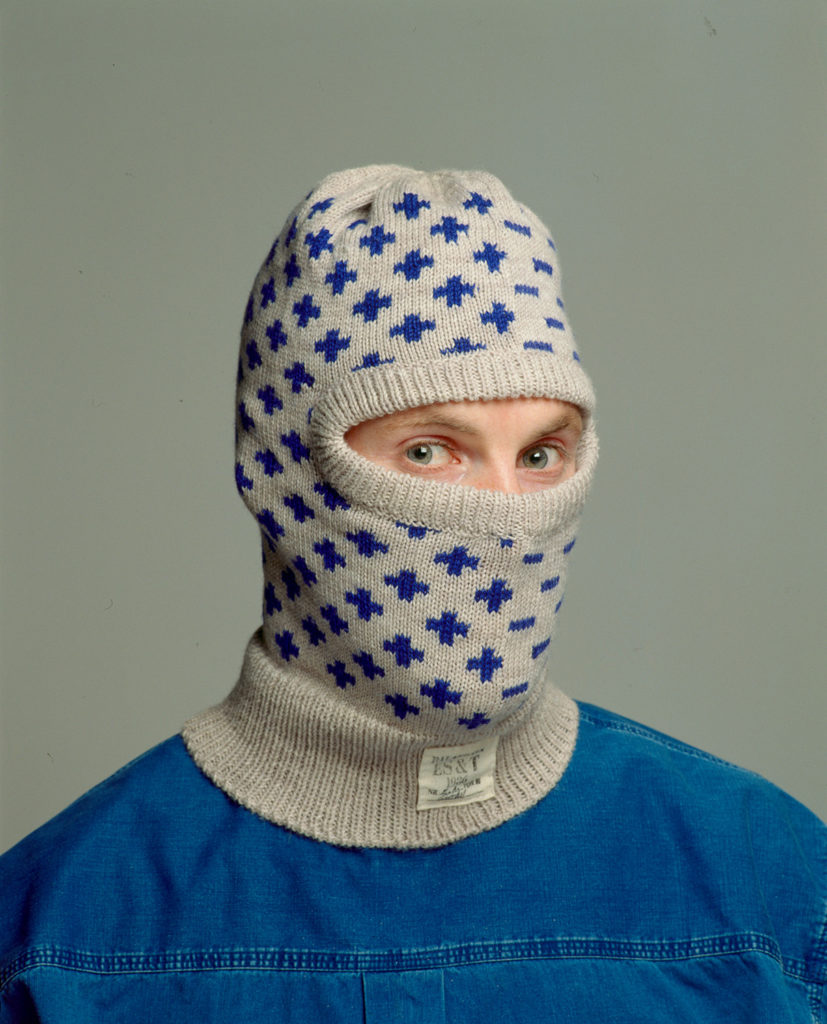CURATOR Gregory Burke OTHER VENUES Auckland Art Gallery, 17 December–20 February 1994; Museum of Contemporary Art, Sydney, 30 March–8 June 1994 PUBLICATION editor Gregory Burke, texts Gregory Burke, Jutta Koether, Robyn Gardner
German artist Rosemarie Trockel's work explores ideas from anthropology and science, notions of female identity, and the relationship between art and craft. Cooly conceptual, but wide ranging in its references and media, it resists easy categorisation.
Trockel is famous for her machine-knitted canvases featuring abstract patterns (including Rorschach patterns) and familiar symbols (including the Playboy Bunny and the communist hammer-and-sickle). Utilising a traditionally female medium, her knitted works are partly a response to a critic who suggested that women are essentially unable to make art. Lacking mouth holes, Trockel's knitted balaclavas imply their wearers will be seen but not heard. Her clinical but comical I See Red Wool—a glass eye peeping out from a ball of red yarn—comments on the success of her knitted works.
Trockel's abstractions refer to the female realm while mimicking minimalist art. She makes paintings from stove hotplates on enamelled steel, alluding to women’s place in the kitchen. Snow Body—a red rug, fringed by poi-shaped tassels—was produced for the show by Dilana Studios, Christchurch. It was inspired by a Māori performance the artist saw in Cologne. Trockel heard that warriors practised poi to keep their wrists supple.
Snow Body is accompanied by the videos Poi Poi, Toi Toi and Pearls, whose twirling motions also nod to Len Lye. There are more videos: Tierfilme (Animal Films, 1978–90) and a found 1932 film, Functions of the Brain, featuring Pavlov’s animal experiments. The show also includes a still from the film, depicting the dissection of a frog.
Trockel’s interest in archives is resonant in the Gallery's new premises, a former public library. Her show is presented behind its façade, in which the words 'Philosophy', 'Religion', 'Sociology', and 'Science' are inscribed in the stone. In the catalogue, curator Gregory Burke explains, ‘Trockel’s art references the rationalising systems inherent in the social sciences which privilege reason over instinct and emotion.’
Trockel's works are cryptic but witty. A white business shirt pierced through the heart with a pin hangs in a vitrine. It buttons on the female side and its label refers to the Marquis de Sade. A live spider placed inside it recalls Adriane’s thread. The Mystery of Malpica (1992) is a knitted lifebuoy. The title refers to a Spanish fishing town where local fishermen often disappear without explanation. Trockel heard this story on a visit to Spain and learnt that none of the fishermen could swim.
Trockel is the international component of City Gallery's opening programme in the new building, which also marks 100 years of women's suffrage. It is presented alongside Alter/Image (a survey of New Zealand feminist art), Te Whare Puanga (weaving and tivaevae by Maori and Pacific Island women in Wellington), and Jacqueline Fraser’s project He Tohu: The New Zealand Room. Director Paula Savage tells City Voice, Trockel’s work is ‘tough and challenging. That’s what the gallery is going to be about.’
The rhetoric doesn’t wash with critic Bob Kerr. In Landfall, he says, ‘The show is more concerned about the need to promote international curatorial and artistic careers than it is about a dialogue with the owners of the gallery, the people who walk in the door. It represents an avant-garde that is really the rearguard fighting to maintain power for itself and its paymasters.’ Others are more receptive. When the show tours to Sydney, Felicity Fenner writes, ‘Rosemarie Trockel’s ability to convey post-modern, feminist and political dialogues in deft lateral movements of the psyche is as smooth as it is spooky, and provides a number of inroads for those willing to penetrate the cool hysteria of her packaging.’









































